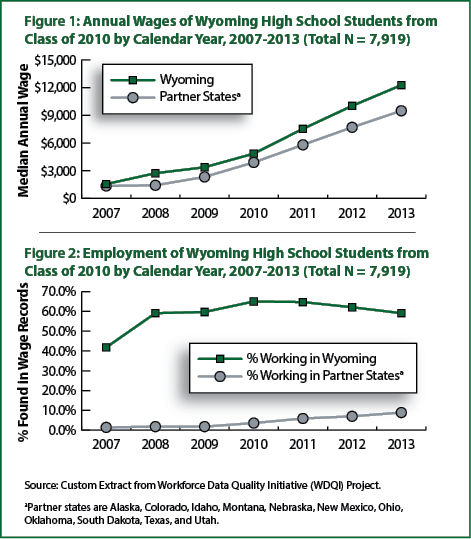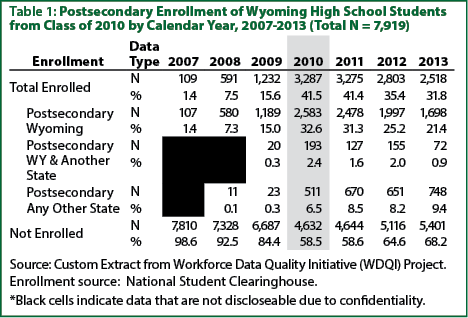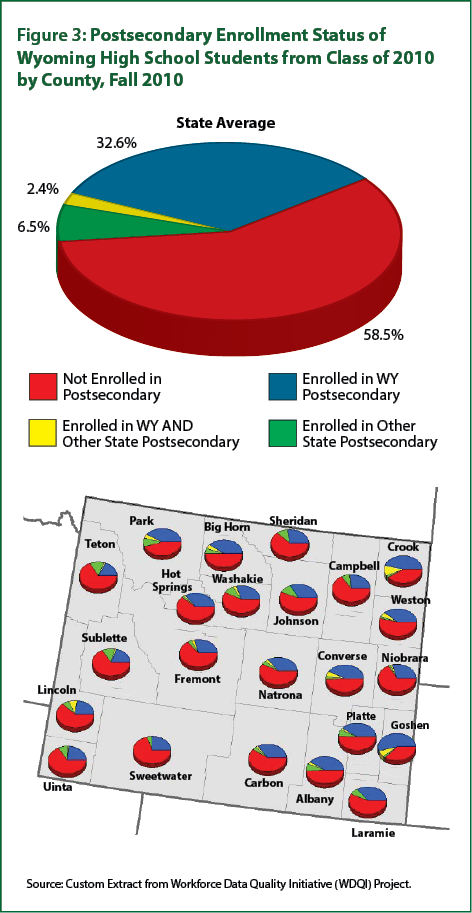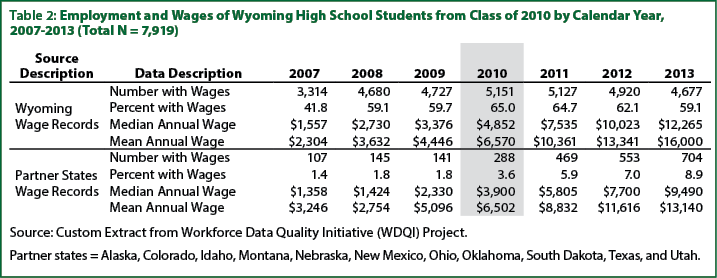
WE Connect: Employment, Earnings, and Postsecondary Enrollment of Wyoming High School Students
Part 1: Wyoming High School Students’ Earnings and Postsecondary Enrollment
What happens to students after they leave Wyoming high schools is a question of importance to educators and policymakers alike. Some high school students go on to attend Wyoming community colleges or the University of Wyoming, while others leave the state to obtain a postsecondary education. Some move directly into the labor market, while others drop out of the labor market for a variety of reasons, such as starting a family. This new series of publications from the Research & Planning (R&P) section of the Wyoming Department of Workforce Services offers a snapshot of what students earn during and after high school (see Figure 1), where they work (see Figure 2), and how many students are enrolled in a postsecondary program in Wyoming and surrounding states (see Figure 3).
The information presented in this series comes from data collected during the administration of public programs in Wyoming, selected states, and the nation. This publication is the first in a series from the Workforce Data Quality Initiative (WDQI) grant and includes data from the Wyoming Department of Education (WDE), the National Student Clearinghouse (NSC), the Wyoming Department of Workforce Services, and the Wyoming Department of Transportation. This publication also uses administrative records from the Unemployment Insurance (UI) systems of other states. Future publications will incorporate data from the Wyoming Community College Commission, the University of Wyoming, Workforce Investment Act trainees, Hathaway Scholarship awardees, and other education and workforce training programs. The publications can be found online at http://doe.state.wy.us/LMI/education_we_connect.htm.
Class of 2010: Postsecondary Enrollment
As an example, this publication focuses on the Class of 2010: Wyoming high school students who were expected to graduate at the end of the 2009/10 school year, whether they graduated or not. Figure 3 and Table 1 show postsecondary enrollment for the 7,919 students in Wyoming’s Class of 2010 from 2007 to 2013. In 2010, 41.5% of the students of the Class of 2010 were enrolled in a postsecondary program – 32.6% in Wyoming, 6.5% in another state, and 2.4% in both Wyoming and another state. The remaining 58.5% of the Class of 2010 were not enrolled in any postsecondary program in 2010.
The paths that Wyoming high school students take vary by county. Figure 3 shows postsecondary enrollment for high school students from the Class of 2010 in fall 2010. In Albany County, for example, 41.3% of all high school students from the Class of 2010 were enrolled in a postsecondary institution in Wyoming in 2010, 7.1% were enrolled in another state, 2.6% were enrolled in both Wyoming and another state, and 51.0% were not enrolled. By comparison, in Sweetwater County, 25.2% were enrolled in Wyoming, 5.2% were enrolled in another state, and 69.0% were not enrolled.
Class of 2010: Employment and Wages
Through data-sharing agreements with Labor Market Information offices in 11 other states (partner states1), R&P is able to track the Class of 2010 over time. As shown in Table 2, 5,151 individuals from the Class of 2010 (65.0%) were found working in Wyoming in 2010, compared to 288 individuals (3.6%) who were found working in partner states. By 2013, the number of individuals from the Class of 2010 found working in Wyoming dropped to 4,677 (59.1% of the total), while the number found working in partner states more than doubled to 704 (8.9% of the total). As shown in Table 2 and illustrated in Figure 1, the median annual wage for those who went to work in other states was consistently lower than the median annual wage for those who worked in Wyoming. By 2013 — three years after the expected year of graduation for the Class of 2010 — the median annual wage for those working in Wyoming was $12,265, compared to $9,490 for those working in partner states. This seems to indicate that individuals who leave Wyoming shortly after high school completion are not leaving for higher wages but for other reasons, perhaps moving with family or to pursue further education.
Future Publications
Forthcoming publications in this series will focus on the wages that students forego in order to pursue a postsecondary education, employment and earnings for students with special needs, labor market outcomes, and the location of postsecondary training and education pursued by Wyoming high school graduates.
1Partner states are Alaska, Colorado, Idaho, Montana, Nebraska, New Mexico, Ohio, Oklahoma, South Dakota, Texas, and Utah.



